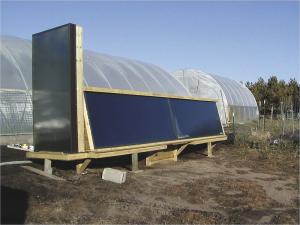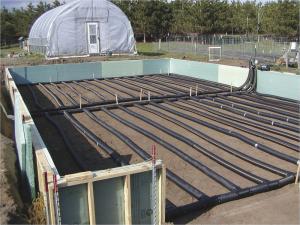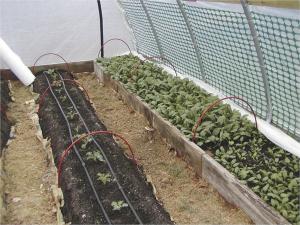Solar-Heated Greenhouse Makes "Exotic" Fruits Possible In Minnesota
Dallas Flynn beats the competition at his northern Minnesota farmer’s market by two months with ripe tomatoes in June and fresh-picked tomatoes in November. He has no competition at all with the peaches, apricots, nectarines, pears and sweet cherries he brings to market each summer. In an area where the ground freezes to a 6-ft. depth, nobody else can grow them. No one else has a solar panel heated greenhouse.
“They said raising fruit trees like these in our area couldn’t be done, and that bothered the heck out of me,” says Flynn. “In early August I pick apricots, two weeks later I pick nectarines and three weeks later I pick peaches.”
What makes Flynn’s greenhouse orchard possible is the warm air beneath its soil and the double layer of plastic over the top. The warm air comes from three solar panels adjacent to the greenhouse. A grant from the Minnesota Department of Agriculture helped with costs.
“I have two 4 by 10-ft. horizontal panels and one 4 by 8-ft. vertical panel,” explains Flynn. “Hot air moves out of the panels through the dirt beneath the greenhouse and back into the panels for reheating.”
Flynn started by excavating a 30 by 48-ft. area to a 4-ft. depth. Wooden sidewalls made with utility grade 2 by 4’s were covered with 4 in. of Styrofoam insulation for the top 2 ft. and 2 in. for the lower 2 ft. A 4-in. thick layer of foam panels covered what was to be the greenhouse floor. It was covered with 1 ft. of coarse sand and a layer of 4-in. corrugated drain tile on 16-in. centers. The tiles were covered with a second layer of 8 to 12 in. of sand. A second layer of drain tile on 16-in. centers was laid in the opposite direction. It too was covered with sandy subsoil, with 18 in. of topsoil laid over it.
“The corrugations give us 8 ft. of surface area for every 5 ft. of tile line,” explains Flynn.
A thermostat turns on fans when the air in the solar panels reaches 125°F and shuts them off when it drops to 85°. The fan pushes air into the panels after it has travelled through the tubes. In the heat of the day, the air gets really hot, notes Flynn.
"I was asked during a tour how hot the air was," he recalls. "I put a plastic thermometer in the cold air return, and it was 72°. I put it in the hot air line, and the thermometer melted."
Raised planting beds are a combination of decayed peat available commercially and native soil. Flynn feeds plants with fish emulsion and liquid kelp through drip irrigation lines on each bed. He also treats each bed with composted manure from his herd of Scottish Highland cattle.
A framework of pairs of treated 4 by 4-in. posts spanned by 2 by 4-in. crossbars support aircraft cable running the length of the greenhouse. Tomato vines and cucumber vines are trained to run up lines to the cable.
In the dead of winter, the solar panels cannot stay ahead of the region's temperatures. The top 12 to 18 in. of soil freezes. Flynn is confident this helps control pests and disease.
“Our goal was to develop a system so a family or group of families could put up a high tunnel and grow their own fruits and vegetables,” says Flynn.
His greenhouse does that for him and his wife and much, much more. In addition to his farmers market stand, he also supplies a large commercial restaurant.
“A typical tomato plant grown outdoors here will produce 5 to 8 lbs. of fruit. We pick 50 lbs. without a problem,” says Flynn. “We picked almost 1,400 lbs. of cucumbers from a 14-ft. row.”
The entire project, including labor and all materials, came to $20,000. The 30 by 48-ft. ClearSpan high tunnel came from Grower’s Supply and included double plastic on the roof with extra purlins to support the area’s expected snowfalls. The solar thermal panels came from RREAL, a non-profit panel maker in Pine River, Minn.
Contact: FARM SHOW Followup, Dallas Flynn, Forest Glen Farm, 48677 Rice Lake Rd., Frazee, Minn. 56544 (ph 218 841-6380 or 218 346-2099; drusadal@hotmail.com).

Click here to download page story appeared in.
Solar-Heated Greenhouse Makes Exotic Fruits Possible In Minnesota BUILDINGS Miscellaneous Dallas Flynn beats the competition at his northern Minnesota farmer’s market by two months with ripe tomatoes in June and fresh-picked tomatoes in November He has no competition at all with the peaches apricots nectarines pears and sweet cherries he brings to market each summer In an area where the ground freezes to a 6-ft depth nobody else can grow them No one else has a solar panel heated greenhouse
“They said raising fruit trees like these in our area couldn’t be done and that bothered the heck out of me ” says Flynn “In early August I pick apricots two weeks later I pick nectarines and three weeks later I pick peaches ”
What makes Flynn’s greenhouse orchard possible is the warm air beneath its soil and the double layer of plastic over the top The warm air comes from three solar panels adjacent to the greenhouse A grant from the Minnesota Department of Agriculture helped with costs
“I have two 4 by 10-ft horizontal panels and one 4 by 8-ft vertical panel ” explains Flynn “Hot air moves out of the panels through the dirt beneath the greenhouse and back into the panels for reheating ”
Flynn started by excavating a 30 by 48-ft area to a 4-ft depth Wooden sidewalls made with utility grade 2 by 4’s were covered with 4 in of Styrofoam insulation for the top 2 ft and 2 in for the lower 2 ft A 4-in thick layer of foam panels covered what was to be the greenhouse floor It was covered with 1 ft of coarse sand and a layer of 4-in corrugated drain tile on 16-in centers The tiles were covered with a second layer of 8 to 12 in of sand A second layer of drain tile on 16-in centers was laid in the opposite direction It too was covered with sandy subsoil with 18 in of topsoil laid over it
“The corrugations give us 8 ft of surface area for every 5 ft of tile line ” explains Flynn
A thermostat turns on fans when the air in the solar panels reaches 125°F and shuts them off when it drops to 85° The fan pushes air into the panels after it has travelled through the tubes In the heat of the day the air gets really hot notes Flynn
I was asked during a tour how hot the air was he recalls I put a plastic thermometer in the cold air return and it was 72° I put it in the hot air line and the thermometer melted
Raised planting beds are a combination of decayed peat available commercially and native soil Flynn feeds plants with fish emulsion and liquid kelp through drip irrigation lines on each bed He also treats each bed with composted manure from his herd of Scottish Highland cattle
A framework of pairs of treated 4 by 4-in posts spanned by 2 by 4-in crossbars support aircraft cable running the length of the greenhouse Tomato vines and cucumber vines are trained to run up lines to the cable
In the dead of winter the solar panels cannot stay ahead of the region s temperatures The top 12 to 18 in of soil freezes Flynn is confident this helps control pests and disease
“Our goal was to develop a system so a family or group of families could put up a high tunnel and grow their own fruits and vegetables ” says Flynn
His greenhouse does that for him and his wife and much much more In addition to his farmers market stand he also supplies a large commercial restaurant
“A typical tomato plant grown outdoors here will produce 5 to 8 lbs of fruit We pick 50 lbs without a problem ” says Flynn “We picked almost 1 400 lbs of cucumbers from a 14-ft row ”
The entire project including labor and all materials came to $20 000 The 30 by 48-ft ClearSpan high tunnel came from Grower’s Supply and included double plastic on the roof with extra purlins to support the area’s expected snowfalls The solar thermal panels came from RREAL a non-profit panel maker in Pine River Minn
Contact: FARM SHOW Followup Dallas Flynn Forest Glen Farm 48677 Rice Lake Rd Frazee Minn 56544 ph 218 841-6380 or 218 346-2099; drusadal@hotmail com








